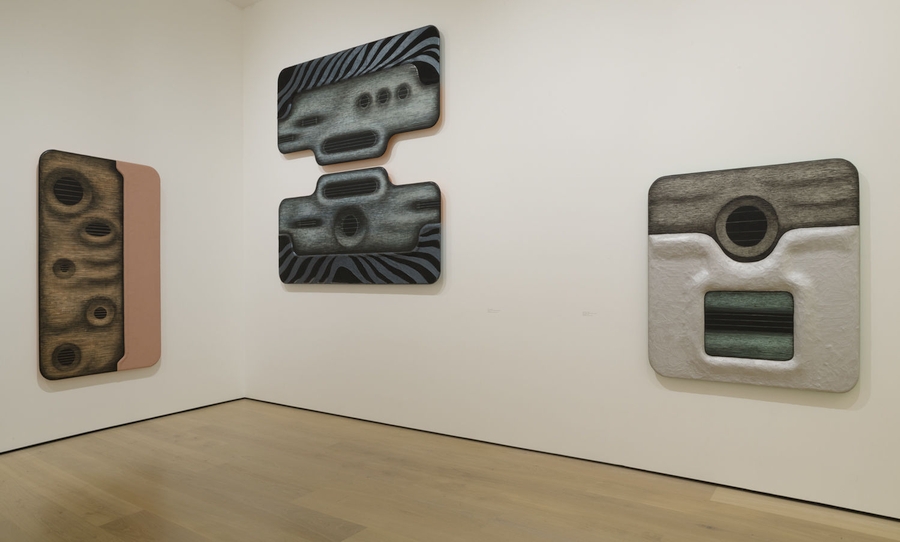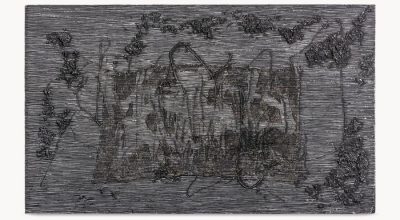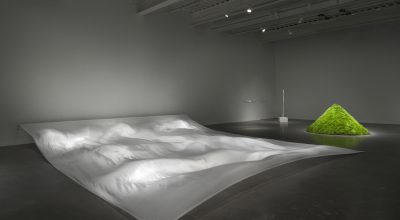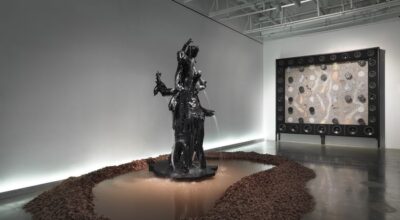
TISHAN HSU: LIQUID CIRCUIT
In the mid-1980s Tishan Hsu (b. 1951, Boston) began a series of works that considered the implications of the accelerated use of technology and artificial intelligence and their impact on the body and human condition. His work is distinct from well-documented approaches to art making in the 1980s that relied upon strategies of appropriation, a use of references to popular culture, as well as Neo-geo and other tendencies toward abstraction.
Yet Hsu’s work takes on minimalist legacies in its reduced forms, and also processes the textures and colors of screens and other aesthetic clues of the emergent information age. The artist’s work throughout this period considers the object’s phenomenological properties and the shifting visual landscape. An artist-intellectual ahead of his time, Hsu worked quietly for many years, largely overlooked or forgotten by the art world –until now.
Tishan Hsu: Liquid Circuit is the New York-based artist’s first museum survey exhibition in the United States. Currently at the SculptureCenter in New York, this travelling, revealing exhibition traces Hsu’s key ideas and demonstrates how they clearly resonate in the works of younger artists coming of age today.




Trained as an architect at MIT, Hsu’s art has an idiosyncratic materiality that is informed by his education and the budding East Village scene of the time. His use of tiles, for instance, suggests the architecture of domestic interiors, but also points to the construction of digital images as many discrete units of data. His use of alkyd, resins, and urethane responds to materials developed and used in burgeoning industries.
Bringing together roughly thirty key sculptures, wall reliefs, drawings and media work from 1980 to 2005, the exhibition includes architectonic paintings and sculptures from the 1980s that considered the materiality of the image in the ever-expanding digital landscape; Hsu’s first experiments in Photoshop that mark some of the earliest instances of artists using the newly available digital photo manipulation software; and a selection of the artist’s drawings and other projects.
Since the mid-1980s, Tishan Hsu’s prescient artistic practice has been probing the cognitive as well as physical effects of transformative technological advances on our lives. Through the use of unusual materials, software tools, and innovative fabrication techniques, his enigmatic paintings and sculptures explore and manifest poetic new ways to engage and reimagine the human body.
«Looking back,» Hsu notes, «the evolution of imaging software, printing technologies, new materials, sensor technology, video and sound have enabled the work to unfold in clearer and more radical ways. The sensibility needed the technology. There has been a synchronicity that I did not expect.»
From early on Hsu’s work began to reflect his “assessment that technology was becoming an extension of the human body,» as Julie Belcove writes, which is “a condition he concluded was destined to intensify over time. Modular tiles in his sculptures echoed bits of digital data; three- dimensional objects hinted at contraptions yet to come. Paintings evoked computer monitors but also blood cells or flesh.» The body, Hsu came to realize, could no longer be represented the way it had been for centuries. He was seeing the future.



Hsu has been making the majority of his paintings on canvas since the late 1980s using a silkscreen process to juxtapose images of his close-up pastel drawings of flesh with appropriated biomedical images of orifices and body parts. The scale of these works is such that the dot matrix of the silkscreens is markedly legible.
His most recent paintings, further, almost announce their techno-mediation through an evident digital reproducibility. Various re-engaged motifs from his visual vocabulary are now warped and morphing into hardware and screens and become part of a larger corporeal entity.
“The appearance of white noise, glitches and dislodged body parts adrift in the grid,» writes Jeppe Ugelvig, «is reminiscent of the ‘cyberpunk’ aesthetics of the early 1990s, which similarly worked to articulate anxieties and fantasies about an uncertain digital future. But while much cybernetic thinking from this era imagined the web as a form of life privileging the immaterial mind (and thus doing away with the body), Hsu’s work insists on the fundamental corporeality of our encounter with such virtual systems. The body figures not as some disposable prosthetic, but as a kind of interface, a place that connects various systems of reality.”
The exhibition demonstrates Hsu’s prophetic practice and exemplifies how art responds to and processes the pressing questions of its time. Tishan Hsu: Liquid Circuit reintroduces the work of this visionary artist to a contemporary audience that has finally caught up with the issues he began to address over thirty years ago.
Tishan Hsu: Liquid Circuit is organized by SculptureCenter, New York, and is curated by Sohrab Mohebbi, Curator-at-Large, with Kyle Dancewicz, Interim Director. Lead Underwriting of Tishan Hsu: Liquid Circuit is provided by Richard Chang / Domus Collection, and Joyce K.H. Liu.
TISHAN HSU: LIQUID CIRCUIT
Hammer Museum, Los Angeles
January 26 –April 19, 2020
*
SculptureCenter, New York
September 24, 2020 –January 25, 2021
*
Rose Art Museum, Brandeis University, Waltham, Massachusetts
October 23, 2020–January 10, 2021
También te puede interesar
Soto.vibrations 1950–1960
Renowned as art history’s leading kinetic artist, Jesús Rafael Soto (Venezuela, 1923-2005) explored the dematerialization, or ‘disintegration’ of the art object, breaking new ground while anticipating conceptual strategies to come. Hauser & Wirth in...
New Museum Presents a Major Retrospective of Hans Haacke
For six decades, Haacke has been a pioneer in kinetic art, environmental art, Conceptual art, and institutional critique. This retrospective at the New Museum brings together a wide range of works, focusing in particular...
VIVIAN CACCURI AND MILES GREENBERG: THE SHADOW OF SPRING
The artists invite audiences to experience how sound waves affect our bodies and to consider the manifold ideological, mechanical, spiritual, and symbolic aspects expressed by sound. With works that point to the unseen dimensions...



